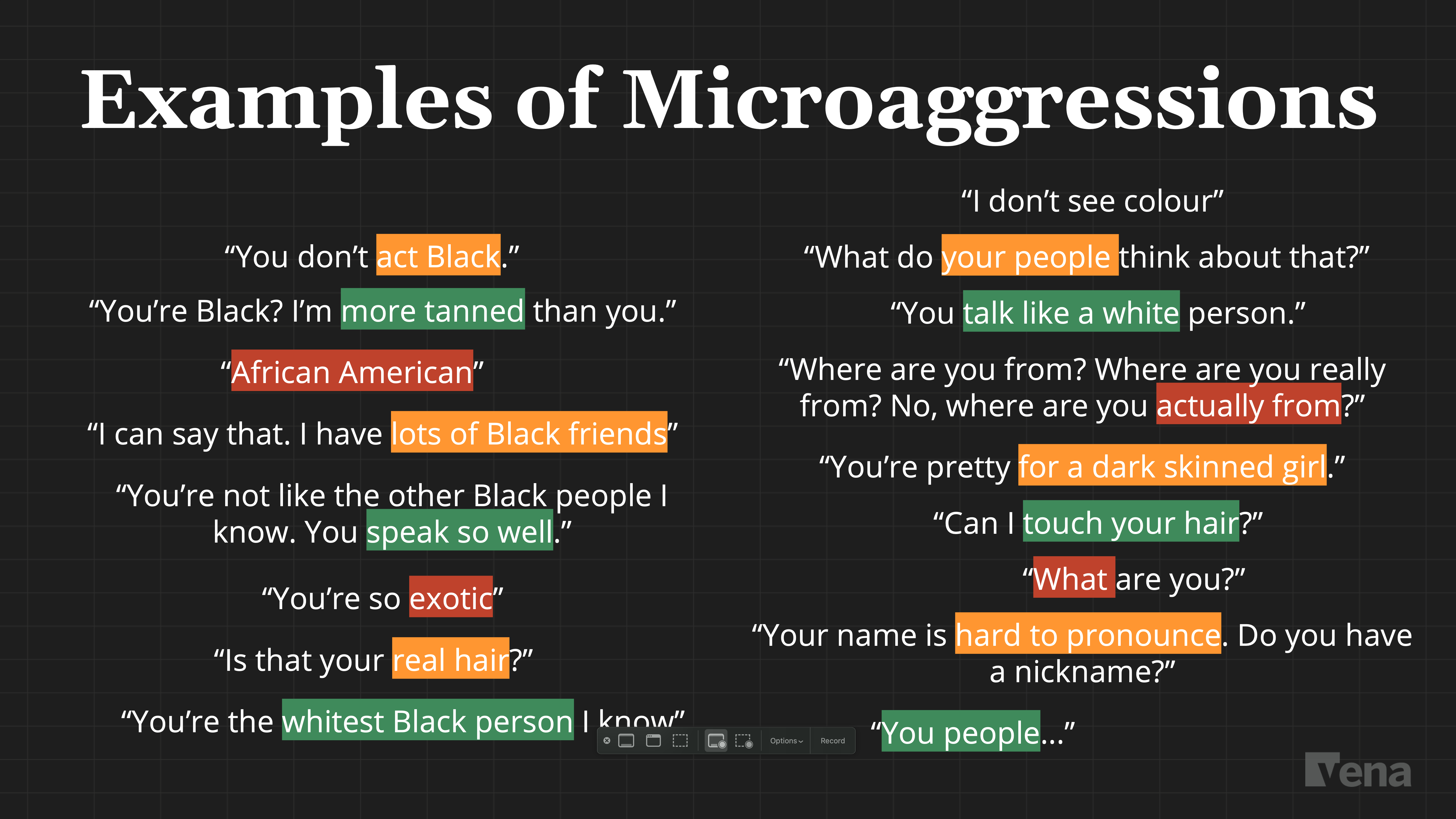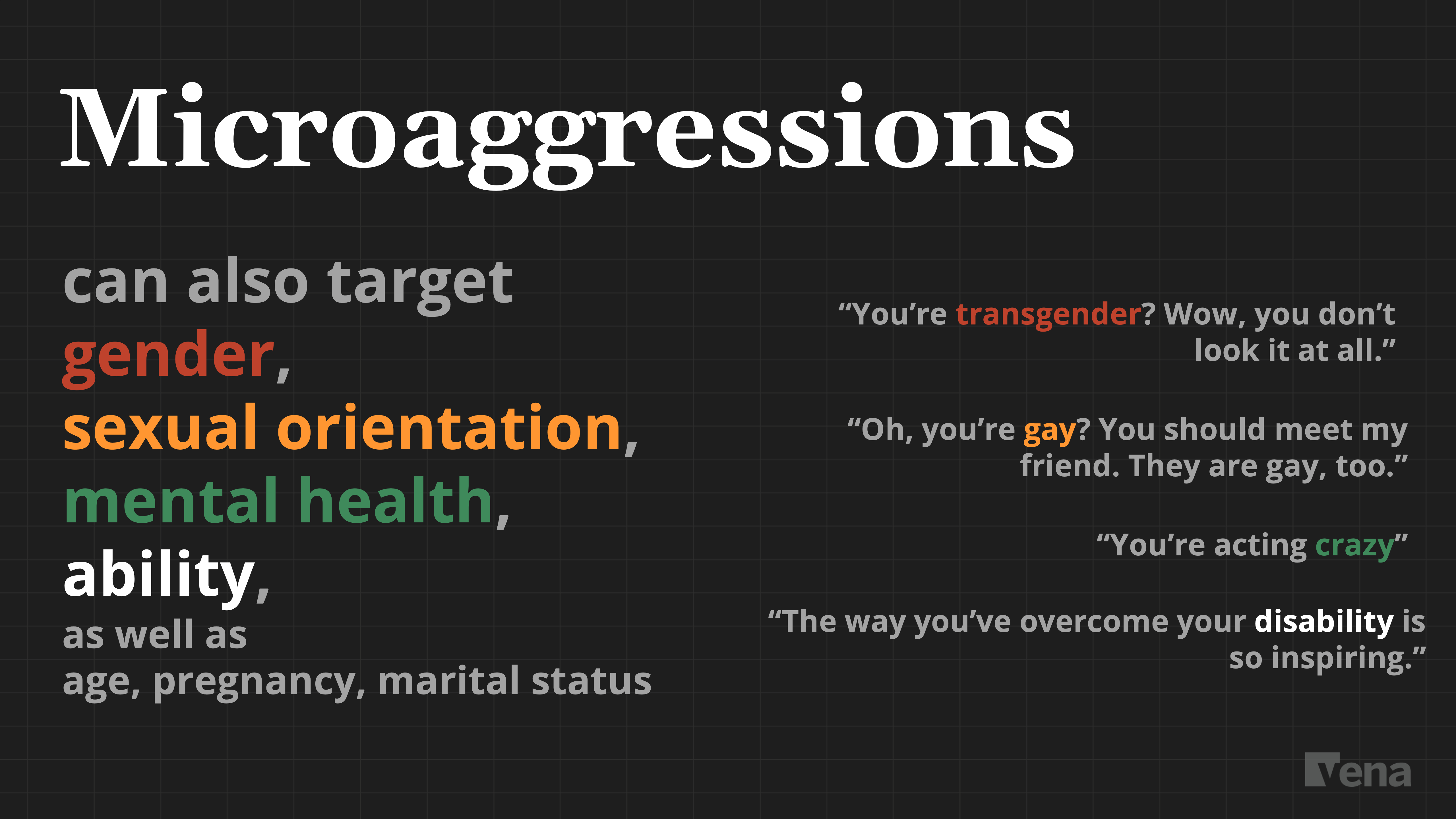
This year during Black History Month, Vena's newly formed Black employee resource group (what we call a Vena resource group or VRG) hosted our second annual Microaggressions Roundtable. Siobhan Mondesire, Senior Director, Digital Strategy at Vena and Co-Chair of Vena's Black VRG, was back to moderate the panel along with Thanusan Chelva, Customer Success Manager, Mid-Market, at Vena.
The theme of this open forum, Creating Space, did just that. It created space for Vena employees to discuss microaggressions--how they show up in personal and work settings--and allyship--how to be a stronger ally in the workplace.
Here are some key takeaways from the roundtable which we hope you'll use to help you become a stronger ally in the workplace.
Read more about Vena's new Black Employee Resource Group.
Siobhan kicked off the discussion with a look at the term "microaggressions," based on the definition by Derald Wing Sue, Professor of Psychology and Education at Columbia University. Defined as "the brief everyday slights, insults, indignities and denigrating messages sent to people of color (members of LGBTQ2A+ communities, people with disabilities, immigrants, etc.) by well-intentioned people who are unaware of the hidden messages being communicated."
The term microaggression was originally coined in the 1970s by Chester M. Pierce, a Harvard psychiatrist. However, the definition of microaggressions that is widely used today can be credited to Sue. He wrote several books on microaggressions, including Microaggressions in Everyday Life: Race, Gender, and Sexual Orientation.
- ÔøΩ - ÔøΩIt's important to note that microaggressions are often discussed in a racial context, but they can also be used in reference to one's gender, sexual orientation, mental health, ability, age, pregnancy or marital status.
Disarming Microaggressions
It's not always easy knowing when and how to respond to microaggressions, especially in the workplace. But that doesn't mean we should let them passively slip by and let them continue happening to us or in front of us.
The best thing you can do is process your emotions, discern the situation and decide how invested you want to be in addressing the microaggression. There are ways to push back and show not only the perpetrator(s), but also onlookers, that the microaggression is unacceptable behavior.
Your responses to microaggressions will vary by situation, context or working relationship. Should you choose to address the microaggression, here are some tips based on Diane Goodman's list of prepared statements to help you disarm and dismantle the microaggression:
When microaggressions are ignored, hidden or excused, it makes them easier to remain invisible. That's why it's important to acknowledge that a microaggression happened, to make the "invisible" visible. Asking for clarification is a great way to address the microaggression. Here are a few examples:
"Could you say more about what you mean by that?"
"How have you come to think that?"
Microaggressions can be tricky due to the disconnect between intent and impact. As Thanusan explained, he has been guilty of saying some of the microaggression examples mentioned above, but at the time, his intent was to be funny or to give a compliment, not to be racist.
We judge ourselves based on our intent, that is, our purpose, design, intention--the act or fact of intending to do something. But we are judged by our impact, the impression made by an idea or action--the influence, impact or effect on something or someone.
Here's how you could go about separating intent from impact:
"I know you didn't realise this, but when you ______ (comment/behavior), it was hurtful/offensive because ______ . Instead, you could (different language or behavior)."
Addressing a microaggression is an opportunity for you to share your own process of dealing with a microaggression. You can do this by providing information, describing your experiences and offering an alternative perspective.
Sharing your own process can sound something like this:
"I noticed that you ______ (comment/behavior). I used to do/say that too, but then I learned."
Imagine going to work every day as a Black person and having to face jokes or inappropriate comments about you from your non-Black colleagues? Over time, microaggressions can take a toll on your mental health and well-being as well as stand in the way of your professional advancements and opportunities in the workplace.
Microaggressions are a contributing factor of racial/ethnic stress, a specific form of general stress which manifests as psychological discomfort when an individual appraises a racial/ethnic situation or event as troubling.
The effects of microaggressions on your mental health can include:
The impacts of microaggressions on your professional life include feelings of being undervalued, preventing you from:
Now imagine you came to work and someone made an inappropriate comment, but an ally jumped in to defend you. Not only can allies--your collaborators, accomplices and co-conspirators who help you fight injustice and promote equity in the workplace--make the workplace feel safer and better for you, you'll also be more energised to go to work and do your best knowing that someone always has your back.
How To Be a Stronger Ally in the Workplace
Recognizing, understanding and acting on microaggressions is a crucial part of allyship, but there are other ways to support people who experience systemic inequities and other barriers to opportunity in the workplace.
Here are some ways to be a stronger ally in the workplace:
Learn more on how to build a culture of diversity, equity and inclusion in your workplace.
